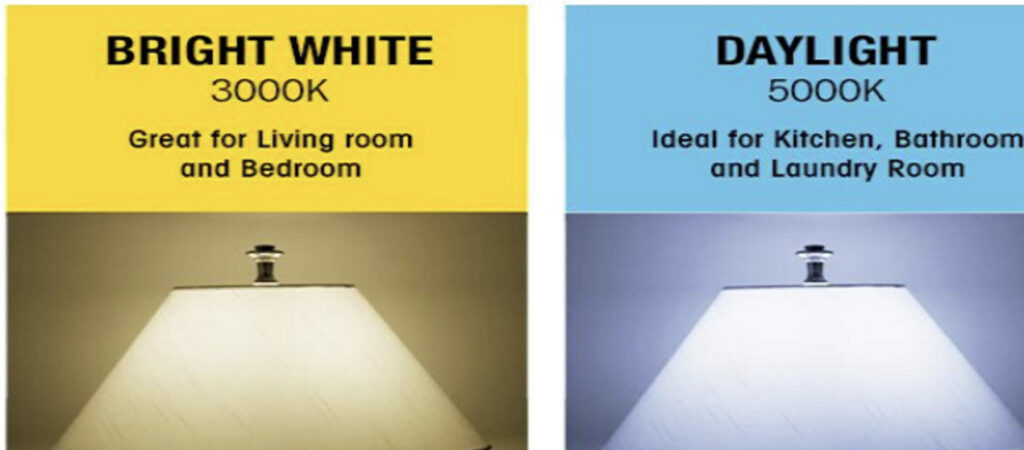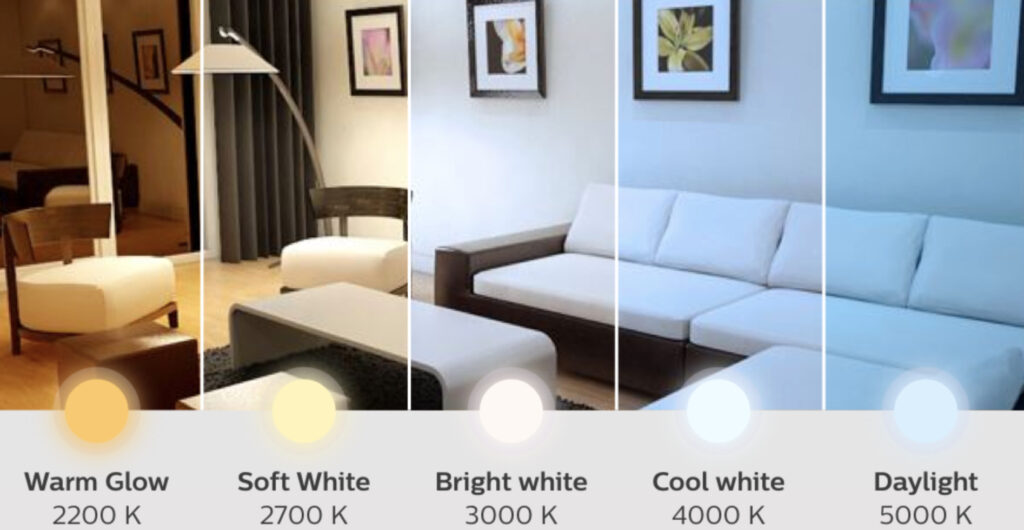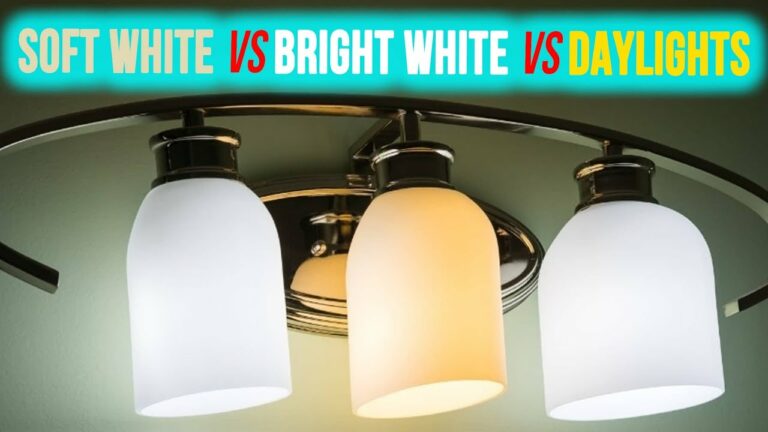While choosing between bright white and daylight bulbs, you may wonder about their distinctive features.
The bright white bulb has a clean, white beam, while the daylight bulb has sharper, blue-white luminosity. A daylight bulb’s luminescence is close to natural daylight, thanks to a higher Kelvin rate.
Main Difference Between Bright White And Daylight Bulbs
If we compare light bulbs with the same power but with different color temperatures, we will notice that a white light bulb (4000K) makes the illumination and color reproduction of surrounding objects more natural than a daylight bulb (5100K).

Measurement of the color of illumination on the white is carried out on the Kelvin scale, and this range is taken from 100 to 10,000 units, commonly called Kelvins.
The range from 2110 to 7000 Kelvins is the most widespread for domestic purposes, also called the color temperature. In this case, 2100 Kelvins is almost orange-yellow, and 7000 is closer to blue, but they are still variations of white.
Both one and another light bulb with such color temperatures will be different in this range, although they will be considered white.
It is generally accepted that a bright white bulb has a color temperature of 3500 Kelvins, and a daylight bulb has 2700 Kelvins. Such definitions as “bright white” and “daylight” are only a classification on the Kelvin scale and have no scientific justification.

It is crucial to comprehend how the Kelvin scale is applied when selecting a white light bulb.
The best option when deciding between an orange and a blue light-emitting source can be considered at 3300 Kelvins. Such light looks very white and natural.
When choosing a light bulb from 4000 Kelvin, you will notice that the white light becomes blue, although it is still white.
After reaching 5000 Kelvin and above, it will be noticeable that the light becomes narrower with a predominant blue on white. It will look unusual and attractive.
Which Is Brighter Daylight Or Bright White?
A daylight bulb will look brighter than bright white based on light temperature. This is due to the fact that this light temperature is quite similar to the shade of daylight.
Bright white is still clear and bright, and in terms of color, the difference in “brightness” is negligible.
Bulb brightness is measured in lumens. This marker, speaking about the brightness of the light bulbs, has a much greater actual value in the perception of light than color temperature.
If we take 40-watt LED daylight, it has a brighter light, but it will still be “2.5” times less effective than a bright 100-watt white bulb.
The higher the lumen output, the brighter the bulb will be, and a daylight bulb will be more colorful with the same luminous flux in lumens.
What Are Other Types Of Color Temperature Bulbs?
The three main categories of light bulb color temperatures are: Soft White (2700K – 3000K), Bright White/Cool White (3500K – 4100K), and Daylight (5000K – 6500K).
The color temperature gets whiter the higher the Degrees Kelvin number. Even though whiter light feels “brighter” than those with a lower Kelvin level, the number of lumens (the unit of brightness measurement) won’t change because this is a result of color temperature rather than actual brightness.
| Color Temperature (Kelvin) | 2000K-3000K | 3100K-4500K | 4600K-6500K |
|---|---|---|---|
| Light Temperature | Warm White | Bright White | Daylight |
| Ambience | Calm, comfortable, inviting | Vibrant, cheerful | Refreshing and stimulating |
| Best Application | Suits for bedroom, living room, kitchen (dining area) | Good for basements, garages, work environments, kitchen (food preparing area) | Great for outdoor enlightenment, garages, above work areas |
What Color Is Closest To Natural Light?
Well, there is no single answer to this question. Natural light color can be affected by conditions such as weather and daytime.
If we talk about a bulb that can be at a close range to natural light, a daylight bulb is the best option since it produces pure white at 5000K.
The soft white bulb has a Kelvin rating of 2000, which reminds me of candlelight. In the evening, soft white creates a relaxing and calming atmosphere after a busy day.
Is bright white or daylight better outdoors?
Daylight bulbs offer much greater visibility in the evening, especially at night. Additionally, it has a slightly wider beam which encompasses a larger area of its reach, meaning that you’ll see all the objects clearly and distinctly.
Bright white light goes well in places with green spaces, flowers, bushes, and grass. Such lighting creates a feeling of the continuation of the day, thereby not disturbing the natural color reproduction of the environment, making the contours of objects look brighter and more voluminous.
Do daylight bulbs use more electricity?
LED bulbs with different color temperatures in Kelvins and the luminous flux in lumens at the same power, for example, 10 watts, will be the same in electricity consumption.
The color temperature and luminous flux do not depend on the light bulb’s power. The LEDs installed inside it play the primary role here. LED control drivers are made according to fundamentally the same circuits and functionally similar electronic components.
Naturally, the energy consumption of such lamps will be the same.
Is daylight or warm white better for eyes?
Improper light can affect our mood and even health conditions. The same goes for our eyes.
If the room illumination is too bright and shiny – our eyes quickly become overstrained or tired, and when the light is close to yellow – our eyes are relaxed and concentrated.
Warm white light is considered better for eyes due three main reasons:
- It contains a low amount of blue light in contrast to daylight, making our eyes feel more tired.
- If your area has a lot of white-shiny objects, warm white light won’t be reflecting them and creating additional discomfort to your eyesight.
- Warm white light can have a soothing and cozy effect which helps to relax and eases the process of sleeping.
Wrapping Things Up
To select the right bulb for yourself, whether white light or daylight, consider the area and its purpose.
If you decide between white light and daylight bulbs, focus on your comfort and additionally confer with light experts.
